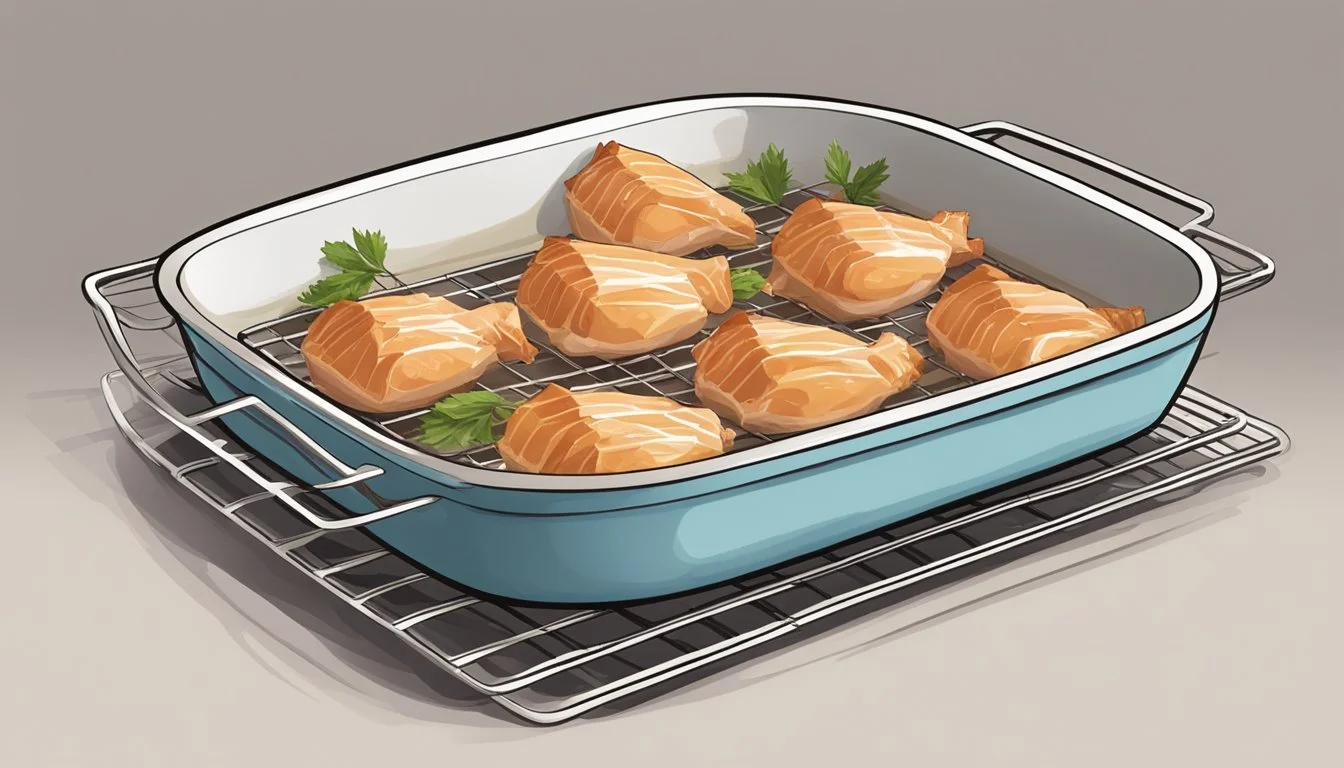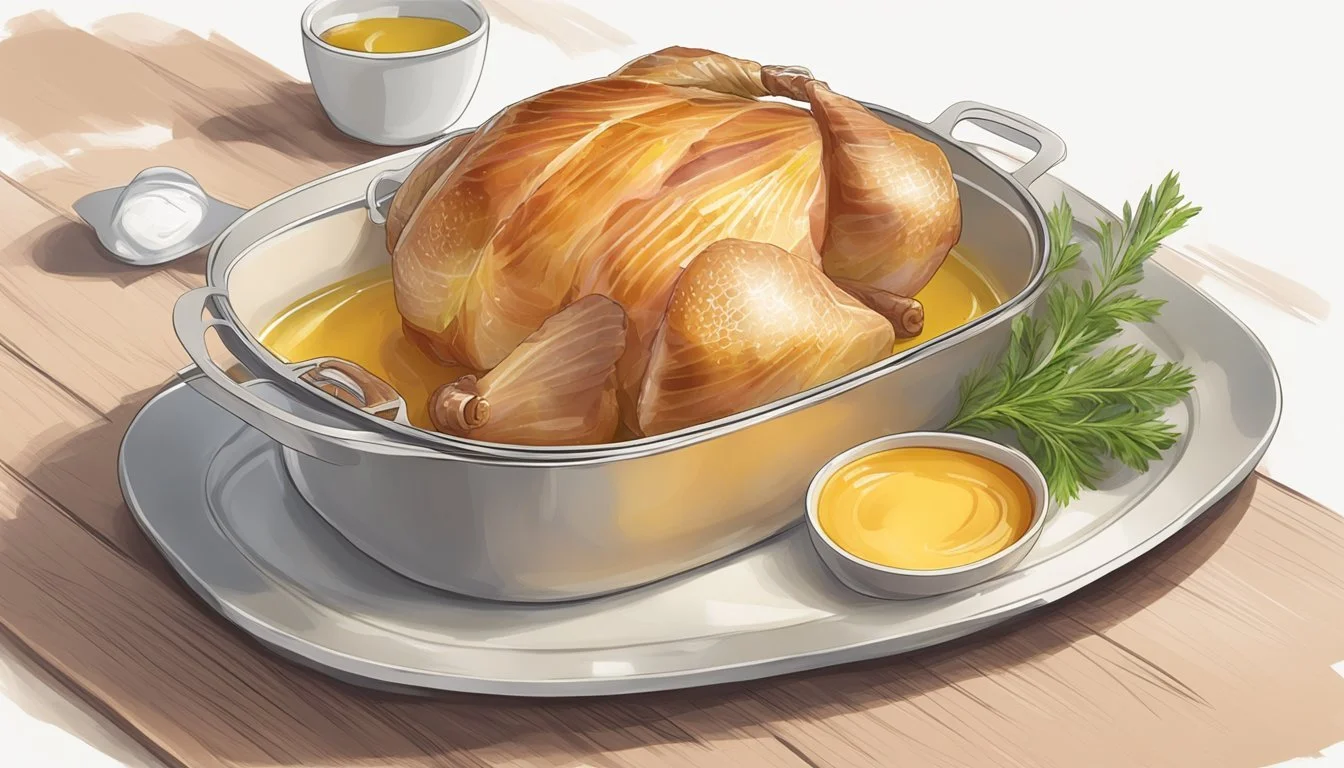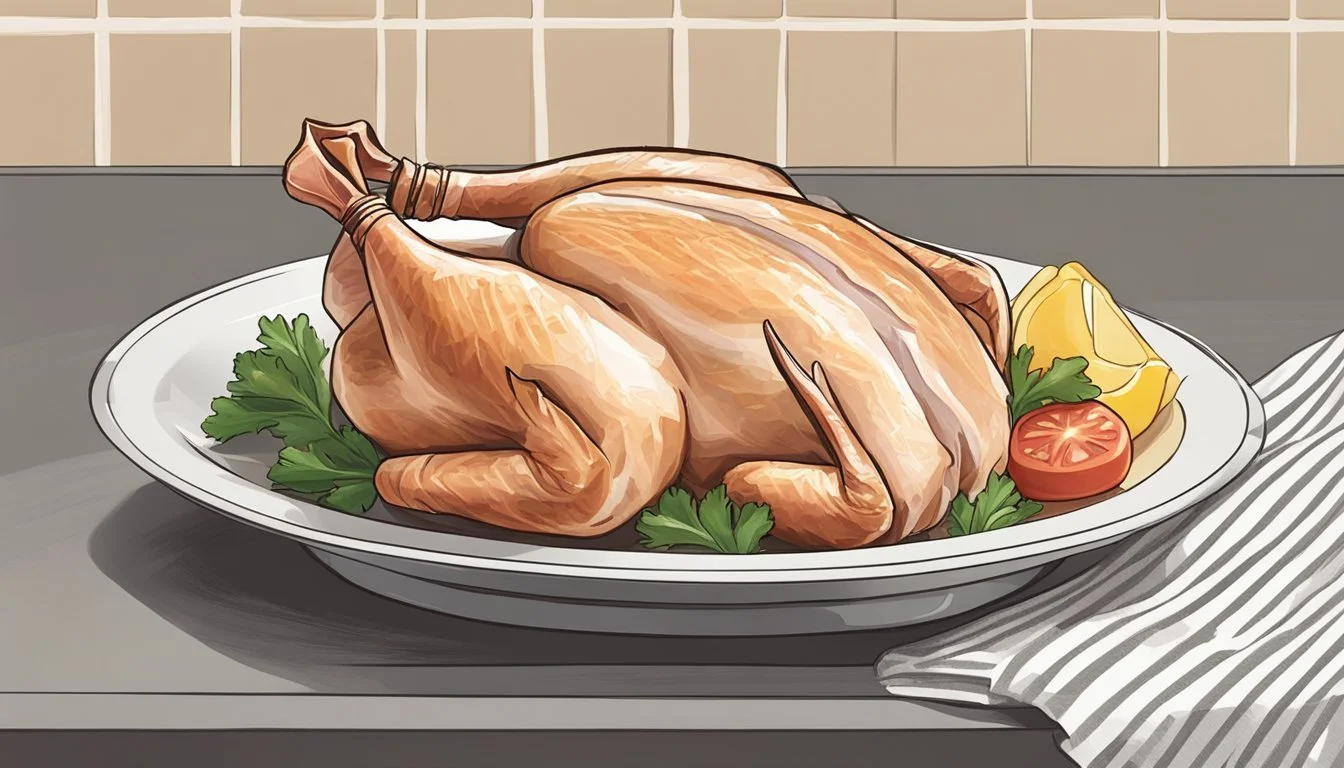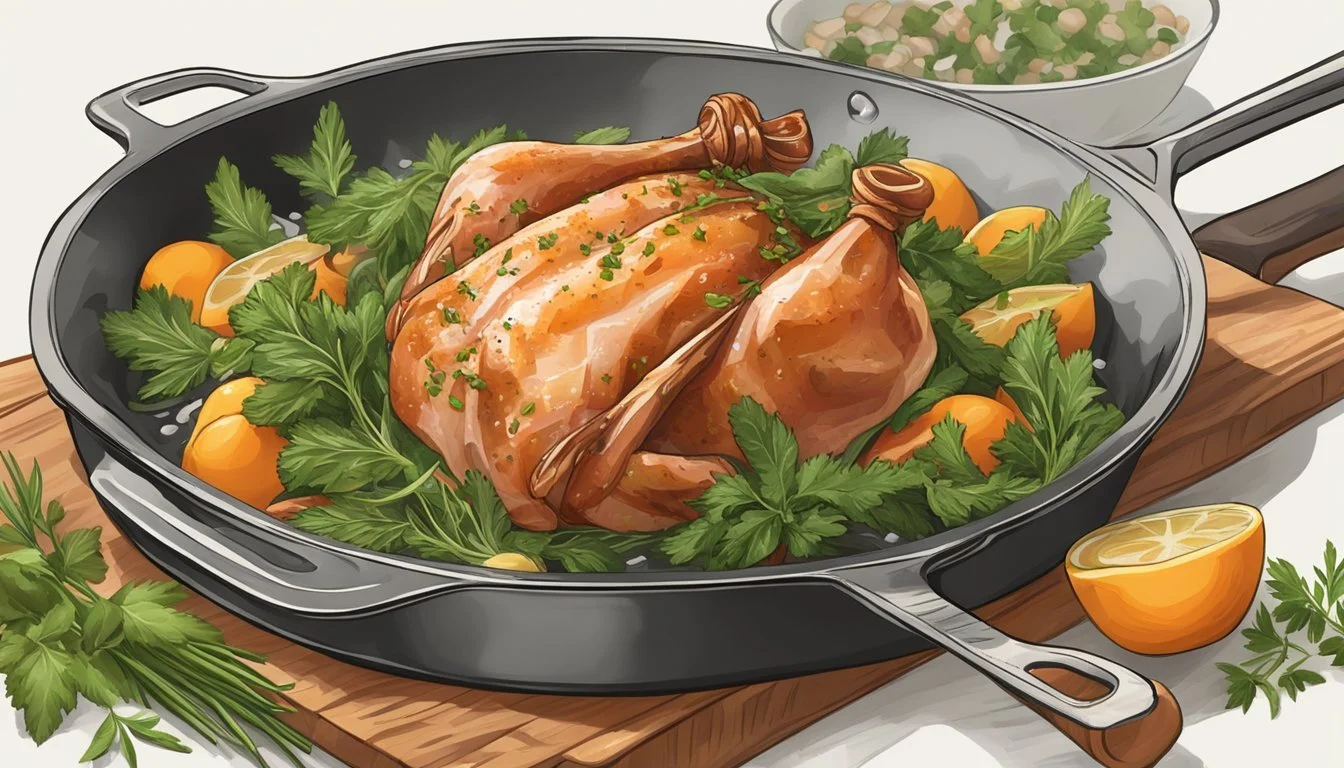Best Way to Reheat Prosciutto Wrapped Chicken
Tips for Succulent Results
Reheating prosciutto-wrapped chicken presents a unique challenge; the goal is to warm the chicken thoroughly while maintaining its moisture and preserving the delicate texture and flavor of the prosciutto. Achieving this balance is crucial, as the contrast between the tender, juicy chicken and the slightly crisp, salty prosciutto is what makes the dish so appealing. It's imperative to use a method that gently warms the meat without causing the prosciutto to become overly tough or the chicken to dry out.
One effective technique to reheat this dish is to use the oven, a method that circulates heat evenly, allowing the chicken to warm throughout without losing too much moisture. Care should be taken to cover the chicken, creating a steamy environment that helps to keep it juicy. Another key aspect is the reheating temperature; setting the oven to a moderate heat level can prevent the edges from drying out before the center is sufficiently warmed. Additionally, it’s essential to monitor the internal temperature of the chicken to ensure it reaches a safe level for consumption. With these considerations in mind, the dish can be restored to its near-original state, ready to be enjoyed once again.
Understanding Prosciutto Wrapped Chicken
The preparation of prosciutto wrapped chicken involves a delicate balance of ingredients and cooking techniques to maintain its moisture and flavor. This section delves into the dish's components, nutritional aspects, and the appropriate selection of chicken for optimal results.
The Composition of Prosciutto Wrapped Chicken
Prosciutto wrapped chicken is a low-carb dish that pairs skinless, boneless chicken breasts with the rich flavors of salty prosciutto and often includes cheese and herbs for added taste. Olive oil may be used to keep the chicken moist while cooking. The ingredients commonly found in this dish include:
Chicken Breast: Preferred for its lean protein
Prosciutto: Thin Italian ham that wraps the chicken
Cheese: Varieties like goat cheese lend a creamy texture
Herbs: Such as thyme, oregano, or basil for flavor enhancement
Garlic: Minced garlic adds depth to the taste profile
Salt & Pepper: Essential for seasoning
Health Considerations and Nutritional Value
Prosciutto wrapped chicken offers substantial protein with the benefit of being low in carbohydrates, making it suitable for those following a low-carb diet. However, prosciutto is high in sodium, and cheese adds fat, which should be taken into account for dietary balance. It's important to consider these points when assessing the meal's nutritional value:
High protein content from both the chicken and prosciutto
Potential high sodium levels from the prosciutto
Added fats from the cheese used in the dish
Selecting the Right Chicken Cut
Finding the right cut of chicken is crucial for a tender outcome. Skinless, boneless chicken breasts are typically used for their uniform shape and ease of cooking. However, other cuts like bone-in, skin-on chicken thighs can be used for a richer flavor, though these cuts may alter the cooking time and method. The best results usually come from:
Boneless Chicken Breasts: For a quick, even cooking
Skinless Cut: To avoid excess fat and achieve the best wrap with the prosciutto
The choice between boneless or bone-in cuts depends on personal preference and desired texture.
Pre-Reheating Preparation
Ensuring moisture retention and safety are pivotal when reheating prosciutto-wrapped chicken. The preparation stage is crucial for maintaining the dish's flavor and texture, as well as adhering to food safety guidelines.
Handling Leftover Chicken Safely
To secure the quality and safety of leftover chicken, it should be stored in the refrigerator within two hours of cooking. One should use airtight containers or wrap the chicken tightly in plastic wrap or aluminum foil to prevent dryness and bacterial growth. The USDA recommends keeping cooked chicken at a temperature of 40°F (4°C) or colder.
Storage Time: Up to 3-4 days in the refrigerator.
Temperature: Maintain refrigerator at 40°F or below.
Prepping Chicken for Reheating
To preserve the chicken's moisture during reheating, prepping the prosciutto-wrapped chicken properly is essential. Begin by letting the chicken rest at room temperature for about 10 minutes before reheating; this minimizes the reheating time and helps to reheat food more evenly.
Steps for Preparation:
Remove the chicken from the fridge.
Unwrap and place it on a plate.
Allow it to sit out for 10 minutes to take the chill off.
Wrap the chicken loosely in aluminum foil to create a steamy environment that keeps the meat moist. Check that the internal temperature reaches the safe mark of 165°F (74°C) during the reheating process to ensure food safety.
Reheating Methods and Techniques
Proper reheating methods are paramount to preserving the moistness and flavor of prosciutto-wrapped chicken. This section delineates precise techniques for reviving leftovers in ways that aim to replicate the dish's original quality.
Oven-Based Reheating
The oven provides a gentle and even heat source for reheating, which is ideal for keeping prosciutto-wrapped chicken moist. To reheat in the oven, one should:
Preheat the oven to 350°F (175°C).
Place the chicken in an oven-safe dish and add a splash of chicken broth, white wine, or lemon juice to foster a moist environment.
Cover the dish with aluminum foil to retain moisture and facilitate even cooking.
Heat the chicken until it reaches an internal temperature of 165°F, typically for about 15-20 minutes.
Stovetop Reheating
Using a stove can reheat chicken quickly with the benefit of adding flavor if done correctly. For stovetop reheating:
Heat a skillet over medium heat and add a little chicken broth or water to prevent sticking.
If the prosciutto-wrapped chicken is bone-in, it's advised to remove the meat from the bone.
Place the chicken in the skillet, turning frequently for an even reheat until the internal temperature is properly restored.
Microwave Reheating
Microwave reheating is fast but requires attention to prevent dryness. When using a microwave:
Place the chicken on a microwave-safe plate.
Cover it with a wet paper towel or a microwave-safe lid to keep the chicken moist.
Reheat at medium power, checking periodically, to avoid overcooking.
Continue until the chicken has reached a safe serving temperature.
Utilizing an Air Fryer
An air fryer can rejuvenate the crispiness of the prosciutto without sacrificing the tenderness of the chicken. To reheat in an air fryer, one should:
Preheat the air fryer to a moderate temperature (around 350°F).
Place the prosciutto-wrapped chicken in the air fryer basket, ensuring pieces don't overlap for an even reheat.
Heat for a few minutes until crispy and warmed to the appropriate serving temperature, checking often.
Ensuring Moisture Retention
When reheating prosciutto-wrapped chicken, key strategies involve gentle heat and moisture-adding components to keep the dish succulent.
Moisture-Enhancing Techniques
Preparation: Begin by lightly brushing the prosciutto-wrapped chicken with olive oil or melted butter to create a barrier that helps retain moisture within the meat.
Foil Wrapping: Carefully wrap the chicken in foil. This method traps steam, which effectively keeps the chicken moist as it reheats. Add a couple of garlic cloves inside the wrapping for additional flavor.
Liquid Addition: Introduce a small amount of chicken broth or a buttery white wine sauce at the bottom of the foil package—just enough to infuse moisture without making the prosciutto soggy.
Reheating Method: Choose a low oven temperature, around 325°F (about 163°C), and allow the chicken to reheat slowly. Monitor the internal temperature, aiming for 165°F (74°C) to ensure safe consumption without overcooking.
Utilizing these techniques ensures that your prosciutto-wrapped chicken remains moist and flavorful throughout the reheating process.
Perfect Pairings and Serving Suggestions
Elevating a dish like prosciutto-wrapped chicken involves thoughtful selection of sides and accents that complement its flavors. Whether it’s a chicken saltimbocca or a baked prosciutto-wrapped chicken breast, these additions ensure a balanced and flavorful meal.
Recommended Side Dishes
A perfect side dish enhances the main course without overpowering it. Prosciutto-wrapped chicken pairs beautifully with sides that offer a counterbalance to its rich flavor:
Asparagus: A classic pairing. Serve steamed or roasted with a spritz of lemon juice.
Roasted Veggies: Mixed vegetables like carrots and zucchini, roasted until caramelized, offer a sweet and savory note.
Crusty Bread: Ideal for sopping up any juices or sauce from the chicken.
Rice: A simple bed of fluffy rice can absorb the flavors of the dish while adding a comforting texture.
For a refreshing companion to the meal, one might choose a glass of Sauvignon Blanc. The wine's acidity cuts through the richness of the meat.
Flavorful Accents and Variations
Incorporating different flavors can turn a simple meal into a memorable one:
Sage and Lemon: Adding sage to the chicken and finishing with a squeeze of lemon juice brings brightness and herbal notes.
Parmesan Cheese: A sprinkle of Parmesan can add a nutty, salty dimension to the chicken.
Brine: A pre-cooking brine with aromatic herbs can ensure the chicken remains juicy and tender.
One should consider these accents and variations to make the dish more intriguing and to keep diners coming back for more.
Storage and Preservation Tips
Proper storage is crucial for maintaining the freshness and flavor of prosciutto wrapped chicken. Whether opting to refrigerate or freeze this dish, the goal is to preserve its moisture and ensure it is as enjoyable as when first cooked.
Freezing and Refrigeration Best Practices
When freezing prosciutto wrapped chicken, one should wrap the chicken tightly in either aluminum foil or plastic wrap before placing it into airtight containers or heavy-duty freezer bags. This helps prevent freezer burn and preserve the chicken's quality. The optimal time frame for freezing is up to 1-2 months. In the case of refrigeration, leftovers should be stored in airtight containers and can be kept for up to 3 days.
To Freeze:
Wrap the chicken securely in aluminum foil or plastic wrap.
Place wrapped chicken in an airtight container or heavy-duty freezer bag.
Store in the freezer for 1-2 months for best quality.
To Refrigerate:
Store in an airtight container.
Keep refrigerated for up to 3 days.
Maintaining Quality of Leftovers
To ensure leftover chicken remains moist upon reheating, it can be beneficial to add a small amount of chicken stock or water before reheating. One should cover the chicken with foil to retain moisture during the reheating process. The chicken should be reheated gently — for instance, in a preheated oven at 350 degrees F (175 degrees C) for about 30 minutes or until heated through to prevent it from drying out.
For Oven Reheating:
Place chicken in an oven-safe dish.
Add a few tablespoons of chicken stock or water.
Cover with aluminum foil.
Reheat at 350°F for approximately 30 minutes.
Using these methods, one can extend the shelf life of prosciutto wrapped chicken while also retaining its moisture and flavor when it's time to enjoy the leftovers.
Frequently Asked Questions (FAQ)
When reheating prosciutto-wrapped chicken, maintaining moistness and preserving flavor are pivotal. This FAQ section addresses common reheating techniques and safety precautions.
Common Concerns When Reheating Chicken
Many individuals are uncertain about the best method to reheat chicken to retain its taste and texture. Various reheating options include:
Microwave: While quick, it can unevenly warm chicken and affect crispness.
Place the chicken on a microwave-safe plate.
Reheat in 30-second intervals, checking temperature intermittently until it reaches the ideal internal temperature of 165°F.
Oven: Preferred for even heating and preserving the prosciutto's crispy edge.
Preheat the oven to 350°F.
Cover chicken with foil to prevent drying out and heat until it reaches an internal temperature of 165°F, typically in about 10 minutes.
Stovetop: Useful for a quick reheat of thin cuts or slices without drying.
Use a skillet over low-medium heat.
Add a few tablespoons of water or broth for moisture, cover, and heat until thoroughly warm.
Air Fryer: Can restore the prosciutto's crispiness but requires attention to avoid overcooking.
Set air fryer to 360°F.
Reheat for about 4-6 minutes, checking with a meat thermometer.
Addressing Safety and Health Queries
Safety should never be neglected when reheating food. Here are some guidelines to ensure health safety:
USDA Guidelines: Adhere strictly to the USDA recommendation of an internal temperature of 165°F to eliminate potential bacteria.
Storage: Leftover chicken should be stored in the refrigerator within two hours of cooking and consumed within 3-4 days.
Meat Thermometer: Always use a meat thermometer to confirm that chicken has uniform internal temperature before consumption.
Avoid Repeated Reheating: Reheat only the portions needed. Repeated reheating can decrease the quality and safety of the food.
Conclusion
Reheating prosciutto-wrapped chicken requires careful attention to retain its moisture and flavor. One must ensure that the chicken is covered to prevent drying out. The oven method, preheated to 350°F, is ideal as it heats the chicken evenly.
Oven Method:
Preheat to 350°F (175°C).
Cover chicken with foil.
Heat for 15-20 minutes until the internal temperature reaches 165°F (74°C).
The stovetop method can also be effective, by adding water to a skillet to create steam, and heating the chicken on medium until it is warmed through to the safe internal temperature.
Stovetop Method:
Add a small amount of water to a skillet.
Heat on medium.
Stir/flip chicken until it reaches 165°F.
One should avoid overheating as it can compromise the quality of the prosciutto and chicken. It's worth mentioning that the chicken should be stored properly before reheating to ensure food safety and quality. The reheating technique chosen can make a significant difference in the outcome, affecting texture and taste.
When followed with precision, these methods maintain the integrity of a flavorful and moist prosciutto-wrapped chicken, delivering an enjoyable meal post-reheating.








